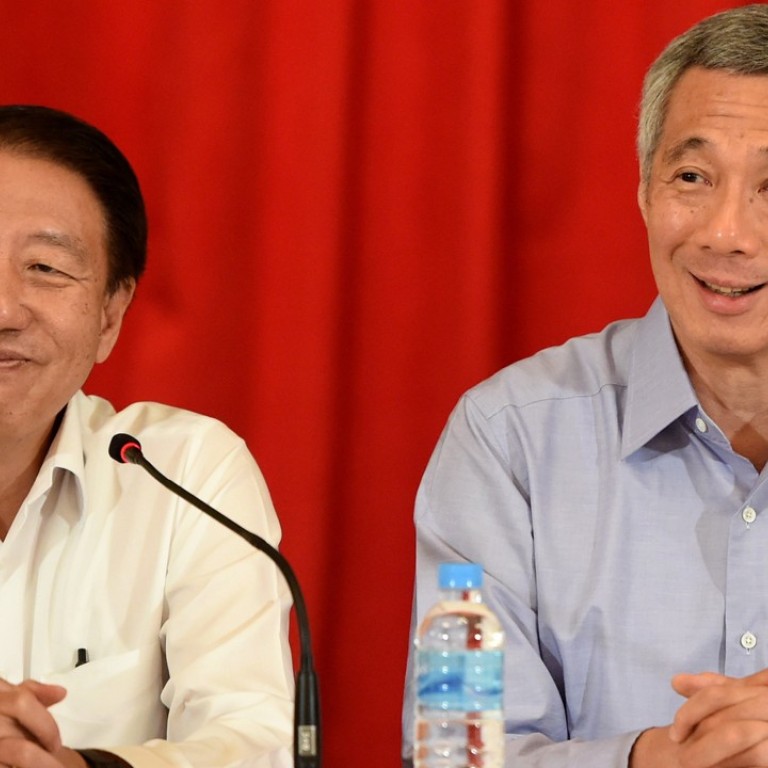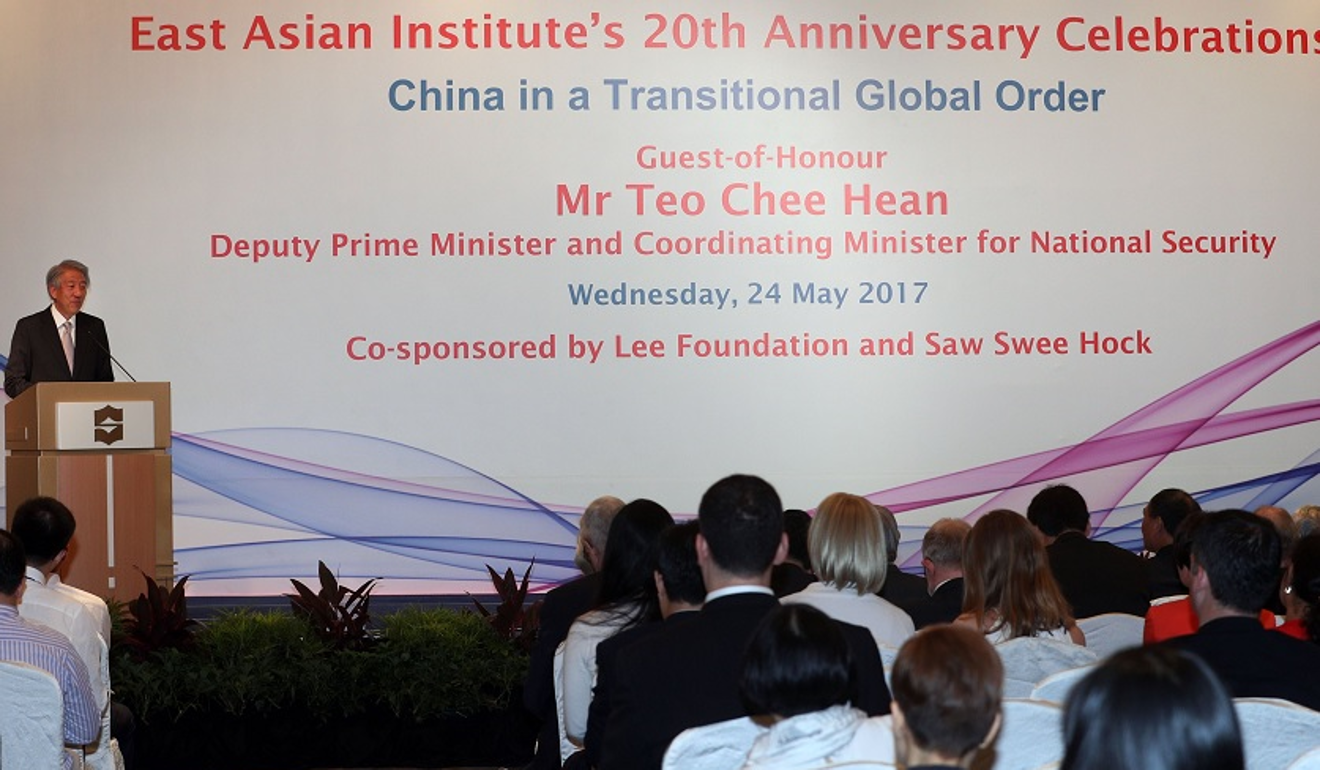
China’s new Silk Road meeting ‘successful’: Singapore’s deputy PM
A week after the Singaporean PM’s absence from the Belt and Road Forum stirred debate regarding China-Singapore ties, his deputy Teo Chee Hean says the countries’ common interests outweigh ‘occasional differences’.
This is an edited excerpt of Teo Chee Hean’s speech at the 20th anniversary celebrations of the city state’s East Asian Institute on Wednesday
I first visited China in 1984 and have had the opportunity to observe China’s transformation over many trips, interactions and exchanges. Most recently, over the past three months, I co-chaired two of our three main bilateral mechanisms with senior Chinese leaders.
The 13th Joint Council for Bilateral Cooperation in Beijing, which I co-chaired with Politburo Standing Committee member and Vice Premier Zhang Gaoli; and just last week, we welcomed Politburo member and Central Organisation Department Minister Zhao Leji for the 6th Singapore-China Forum on Leadership here in Singapore.
What Belt and Road snub means for Singapore’s ties with China
We had a wide-ranging exchange of views on issues of common interest between our two countries. Such dialogues reflect the high level of mutual trust between our countries, and our mutual desire to learn from the experiences of each other. It is a unique dialogue for both countries.
They also provide a valuable platform for a new generation of leaders from our two countries to develop a deeper understanding and appreciation for each other. Today, China’s weight in the world has undoubtedly grown – in the economic, social, international relations and political domains.
First, China’s economy. China’s growth moderated to about 6.7 per cent in 2016.

While it no longer enjoys the double-digit growth rates of the early decades of its economic opening, this is a more sustainable rate given the maturing Chinese economy. It is shifting from an economy characterised by low-wage labour towards innovation and productivity, and moving up the value chain. Skill and care are required to manage this transition.
Within 10 years of joining the WTO in 2001, China had become the top trading partner for all key Asia-Pacific economies – Australia, Japan, the Republic of Korea, India and Asean.
For ASEAN, excluding intra-Asean trade, China is now Asean’s largest trading partner. In 2015, China accounted for 15 per cent of Asean’s trade, compared to just 4 per cent in 2001. Since 2015, China has also become a global player in a new dimension, as a net exporter of capital and investments.
China has also gone beyond being the “factory of the world” to creating global brands. Private enterprises especially in the digital economy such as WeChat and Didi Chuxing are transforming delivery of services within China and producing high-end products.
Can China really deliver Malaysia’s Singapore slayer?
At the same time, China is increasingly aware of the impact of its rapid economic growth on its environment. The government has started to take action domestically, and takes its responsibilities in the global arena seriously through its early ratification of the Paris Agreement on climate change. Chinese companies are now global leaders in clean technology, electric vehicles and batteries.
‘HUGE AND CHALLENGING TASK’
Meanwhile, China needs to restructure its economy and reduce excess capacity in certain key sectors, and transform its state-owned enterprises. This is a huge and challenging task.
We are optimistic that China will develop an innovative, productive economy with greater contribution from services and its private sector. A prosperous and stable China benefits the region and the world.
Second, on the social front, Chinese leaders are keenly aware of the domestic hot-button livelihood issues that they need to address, such as unemployment, inflation, housing and air pollution. China will face some headwinds to sustain its economic growth as its demographic profile changes. China’s population is ageing fast. Nearly 15 per cent are over 60 years old, and by 2030, it will be 25 per cent. Its workforce growth is also slowing and will plateau. This will pose major challenges to family and social structures, and healthcare and pension systems.

The Chinese Government will need to cater to the younger generations of Chinese who have higher aspirations and expectations than their parents.
Many of these social challenges are not unique and Singapore too faces these issues. A comparative study of how these challenges are being addressed in East Asian societies, which have similar societal norms and values, would be quite instructive and help inform family and social policy in East Asia, including China. I also co-chair the Singapore-China Social Governance Forum with Politburo member and Political and Legal Affairs Commission Secretary Meng Jianzhu, where we share our experiences and exchange views on how we can address some of the common challenges in our changing social landscape. We hope to continue these mutually beneficial exchanges for a long time.
CHINA’S INTERNATIONAL ROLE
Third, as China grows in economic and military weight, it will play a more significant international role. China has launched the Belt and Road initiative and the Asian Infrastructure Investment Bank (AIIB) to connect countries across various regions. Singapore supports both initiatives. We saw early on how these initiatives will encourage further economic integration and infrastructure development. Beijing recently held a successful “Belt and Road” Forum. President Xi Jinping’s pledge of over US$100 billion for Belt and Road infrastructure projects over 56 economic zones in 20 countries was very well-received. China’s initiatives will benefit our region and countries along the Belt and Road, where there is significant demand for infrastructure funding.
Beijing warns Lion City about ‘remarks’ over army vehicles
Furthermore, in spite of the global uncertainties over trade protectionism, China has embarked on the key tasks of internationalising the Renminbi and supporting global trade. By 2015, the Renminbi was the fifth most used currency for payments. Hong Kong, London and Singapore are now the three largest Renminbi clearing centres. Since 2016, the Renminbi has been included in the IMF basket of reserve currencies. The internationalisation of the Renminbi will provide more opportunities for Chinese companies to venture overseas, and work with other companies in third markets.

In defence, China saw its budget increase by 7 per cent to some US$150 billion this year. To provide some context, though it is the second highest in the world, it is about a quarter of the US defence budget of US$600 billion.
Under President Xi Jinping’s plans to streamline and upgrade the Chinese People’s Liberation Army, the PLA Navy has been undergoing major developments to bring it closer to being able to operate beyond the near waters to more distant waters. As the major trading nation that China has become in the last twenty years, China will increasingly depend on international cooperation and conventions to ensure that its shipping and goods can proceed unhindered in all parts of the world. Recent deployments by the PLA Navy to join other navies, to protect international shipping against piracy in the Gulf of Aden are a case in point. No country can do this alone.
The Singapore Navy too worked with the Chinese Navy in the Gulf of Aden. The Chinese frigate Huangshan that visited Changi Naval Base last week was one of the PLA Navy ships that our Navy had frequent interactions with in the Gulf of Aden.
‘Give me back my Terrex’: How Hong Kong saga inspired Singapore’s bloggers
Singapore Navy ships also visit China frequently; our frigate RSS Steadfast visited Shanghai last September and conducted a bilateral exercise with the Chinese frigate Jingzhou.
China is also developing its cultural products such as in the arts and film. Many of these Chinese works are widely available on various online media platforms. It has about 480 Confucius Institutes globally facilitating cultural exchanges and the learning of the Chinese language.
POLITICAL EVOLUTION
Fourth, political evolution in China. The 19th National Congress later this year will shape the political landscape in China for the next decade. President Xi has already taken important steps to strengthen party discipline through his anti-corruption drive and re-organised key State and Party institutions, including the People’s Liberation Army. The Communist Party of China (or “CPC” in short) has made great efforts to update itself. I have visited the Central Party School in Beijing as well as the three executive leadership academies in Yan’an, Pudong and Jinggangshan. The CPC is building the capabilities of its cadres to lead a modern economy, a population with raised aspirations, and a society that already has more than 730 million people connected to the internet. At the same time, it is re-visiting key inflexion points in its history such as the Long March in the mid-1930s, to renew and re-dedicate itself to values which have bonded the Party and the people.

At the CPC’s 95th anniversary in 2016, President Xi urged the CPC to “listen to the voice of the times”, be innovative in theory and in practice, and adapt the CPC’s founding ideology to the current development realities and priorities in China. I am optimistic about China’s potential to continually reinvent itself and play a greater leadership role both within the region and globally.
SINGAPORE-CHINA RELATIONS
Singapore-China relations have been aptly characterised as an “All-Round Cooperative Partnership Progressing with the Times”, during President Xi Jinping’s State Visit to Singapore in conjunction with 25 years of diplomatic relations in 2015. This reflects the depth, breadth and strength of our long-standing bilateral ties, and the bright prospects for the future. Singapore and China have worked closely together, and Singapore has been a consistent friend and supporter of China’s peaceful development. Each of our Government-to-Government projects, namely the Suzhou Industrial Park, the Tianjin Eco-City, and the Chongqing Connectivity Initiative, and major platforms such as the Leadership Forum and Social Governance Forum, have supported China’s developmental priorities at key stages. Singapore and China have a broad and longstanding relationship.
We share similar views on most issues, and have worked well together to advance these common interests. But even among close neighbours and friends, there may be different perspectives on some issues, given that countries are of different sizes, have different histories, vulnerabilities, and geographical location.
Hong Kong’s Singaporean armoured vehicle saga finally comes to an end
But the fundamental position of our two countries, that we share a common interest in the peaceful growth and development of our two countries and the region remains the same. Our common interest in building a peaceful and growing region is much greater than any occasional differences of views. Singapore will continue to be a strong and principled supporter of China’s peaceful development and constructive engagement in the region.
With that, I have three hopes for China: First, for a China that is stable and prosperous, even more integrated with the region and the world; Second, a China which continues to contribute to developing international norms and rules for the benefit of all, in order to preserve peace, stability, growth and development. Third, for a China that draws on its long history and deep culture to find a harmonious blend with modernity, as China continues making its societal transformation.
The East Asian story is an exciting and dynamic one, continuing to unfold. China is a key player in the story, and Singapore is a part of this great drama.
Teo Chee Hean is deputy prime minister of Singapore

.jpg?itok=whzvDeFu&v=1653714745)